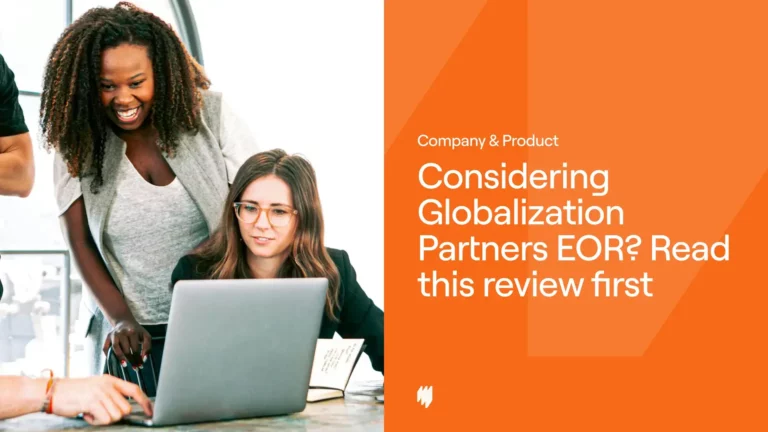Global hiring is no longer just an option; it’s a strategic imperative for modern organizations. But with compliance, payroll, and regulatory requirements lurking at every step, the journey to building a global team is often easier imagined than achieved.
Enter Deel, the go-to Agency of Record (AOR) designed to simplify the complexities of international hiring. With a streamlined and efficient approach, Deel manages compliance, payroll, and regulatory requirements, allowing organizations to focus on growth rather than administrative hurdles.
But does Deel truly deliver on its promise to simplify these high-stakes processes? A closer look at its capabilities can help decision-makers see if it’s the right fit for their global hiring goals. And this article does exactly that. Read on!
Deel as your AOR
Deel’s AOR empowers businesses with a structured approach to hiring and compensating contractors while ensuring compliance with regulatory requirements. It helps businesses manage both contractors and their employees on a single platform, thereby optimizing routine processes and maximizing efficiency.
Some of the most important features of Deel agency of record (AOR) are
- Global payroll solution: Ensures error-free, compliant, and timely payroll processing for employees and contractors in over 150 countries.
- Contractor classification: Assists businesses in accurately identifying independent contractors, minimizing the risk of misclassification.
- Contractor engagement: Streamlines onboarding and ensures compliant payment practices for contractors.
- Contractor agreement localization: Allows businesses to customize contracts in line with local legal requirements.
- Employer of Record (EOR) services: Facilitates hiring employees in new markets without the need to establish a legal entity.
This covers the key aspects of Deel’s highly regarded Agency of Record services. Now, let’s delve into the must-have features that define an ideal global AOR provider.
Key features every AOR should offer
Here are a few non-negotiables that every AOR provider should offer.
1. Correct independent contractor classification
A proper AOR provider must know how to classify the workers’ status. It includes an analysis of work relationships with a clear distinction between an employee and a contractor and accurate documentation to keep misclassifications at bay. The provider should be well-informed about recent changes in labor laws to ensure classifications remain valid across all jurisdictions.
2. Contract management
AOR services should also have a contract management system with templates tailored to local requirements. This system should handle all aspects of contract management, from drafting to securely storing them.
3. Invoices and payments
The provider should provide easy-to-process invoices and pay mechanisms across multiple currencies and geographies, from automated invoice generation and payment through multiple formats to timely processing with clear fee structures. They should also manage records of payments for financial tracking and tax purposes.
4. Ongoing compliance
Continuous compliance monitoring is also equally critical. The provider needs to monitor all regulations and, most importantly, update them into current practices. This should also include regular auditing or risk assessment and proactive updates for compliance.
5. Dedicated support and domain expertise
A reliable AOR platform provider should ensure support from knowledgeable professionals who understand the nuances of various markets and regulations. This includes providing dedicated account managers, legal experts, and a responsive customer service team that can promptly address inquiries and concerns, ensuring a smooth experience for clients.
5 Challenges faced by users of Deel Agency of Record
While Deel is a widely used Employer of Record (EOR) and AOR service, some users have reported challenges, including
1. Limited local benefits administration
There is no denying that Deel effectively manages basic contractor payments; however, when it comes to handling comprehensive local benefits packages, Deel faulters to an extent.
On the other hand, many users have raised concerns about limited customization options to meet specific regional requirements and the challenges of implementing complex payroll structures that differ from standard payment processes.
2. Complex pricing structure
As companies scale, Deel’s pricing structure tends to become costly, particularly for those managing a diverse range of contractor needs. The potential for numerous add-ons and service charges can significantly impact the overall expense, making budgetary planning more complex and challenging for growing companies. This unpredictability in costs may hinder financial forecasting and strain resources as businesses expand.
3. Communication and time zone barriers
While Deel provides global support, response times can occasionally lag due to time zone differences. This can be challenging, particularly for users who require urgent answers to complex compliance questions that need an immediate response.
4. Platform learning curve
Deel’s platform is generally user friendly. However, it can be too complex for a beginner to understand its features and compliance needs. This means organizations that migrate from simpler systems would need to spend a good amount of time grasping and understanding those tools and functionalities.
5. Integration limitations
Integrating Deel with certain HR and payroll systems can be quite a tricky affair at times. Its limited compatibility with some third-party tools often results in additional manual work for HR teams, reducing efficiency and adding to administrative burdens. This can be particularly challenging for firms that already have established HRIS platforms.
These limitations are crucial for organizations evaluating Deel as their AOR provider. Being aware of these challenges can support more informed decision-making and allow for proactive planning to mitigate potential issues.
5 Ways Multiplier AOR address these challenges
Here are the top five ways Multiplier AOR solves the challenges discussed in the previous section:
1. Comprehensive benefits management
Multiplier distinguishes itself with a comprehensive benefits management system tailored to diverse regional needs. The platform enables organizations to create region-specific benefits packages that align precisely with local markets while upholding international standards.
What sets Multiplier Agency of Record stand out is the ability to manage complicated payroll structures such as numerous insurances, retirement benefits, and location-based incentives, while staying compliant with local regulatory needs.
2. Transparent cost structure
Unlike many complex pricing models, Multiplier prioritizes transparency in its cost structure with an all-inclusive pricing approach. This allows organizations to easily understand and predict their expenses, alleviating concerns about hidden fees or unexpected charges.
This relatively simple pricing model encompasses everything from the basic service fees to currency conversion and makes budget planning and financial forecasting quite easy for businesses of any type and size.
3. Enhanced global support system
Multiplier effectively addresses communication challenges by implementing a comprehensive support network worldwide. Their 24/7 support system includes dedicated teams in multiple time zones, ensuring customers receive the assistance they require, no matter where they are.
Moreover, Multiplier addresses urgent matters promptly and maintains high-quality standards with local experts in every region, complemented by multilingual support to cater to diverse client needs.
4. User-friendly platform
Multiplier’s platform is built with user-friendliness at its core, offering an intuitive experience that simplifies complicated global employment processes. The platform provides clear, step-by-step guidance and robust support tools, ensuring users can easily navigate complex employment processes.
By streamlining workflows and offering practical resources, Multiplier enables organizations to efficiently manage a global workforce, minimizing administrative hassle and maximizing productivity.
5. Advanced integration capabilities
Multiplier provides excellent system integration options that seamlessly connect with various tools. It effortlessly integrates with any HRIS systems, payroll software, and accounting platforms, significantly reducing the need for manual data entry.
With regular upgrades and maintenance, Multiplier ensures that these integrated systems operate efficiently and flawlessly across all connected platforms.
Checklist for switching from Deel AOR to Multiplier AOR
Planning ahead and executing the transition systematically is essential to minimize disruptions for both your business and your contractors. To ensure a smooth transfer from Deel AOR to Multiplier AOR, follow the checklist below for a seamless and efficient process:
1. Audit current contractor documentation and agreements
The first and foremost step is to check all of the contractor agreements, payment histories, and compliance paperwork in your Deel system. Then, create a complete spreadsheet accounting for all current contractors, including their payment terms and benefits.
This will eventually allow you to identify specific contractual responsibilities or special requirements that must remain constant during the transition phase. Essentially, focus on notice periods, termination clauses, and existing projects to prevent any confusion during the switch.
2. Plan a strategic timeline for migration
Develop a comprehensive timeline that takes into consideration both the technical and human factors involved in the transition. Focus on specifics like project cycles, deadlines, and local notice requirements to ensure the process aligns smoothly with your operational needs. Aim to schedule the transition during periods of minimal activity to reduce disruptions.
Additionally, include time buffers to account for potential delays and communicate with contractors, allowing them time to adapt to the new system.
3. Prepare contractor communication and support strategy
Transparency is key when you switch your AOR provider. A clear communication plan should be developed to inform contractors of the change with clear instructions on the transfer process, new payment schedules, and any actions they need to take.
Develop FAQ materials to address questions and offer specialized assistance channels for transition-related concerns. Additionally, provide tutorial videos, manuals, and direct contact numbers to help contractors fully understand and navigate Multiplier’s platform effectively.
4. Configure new Multiplier platform settings
Before you finally switch, make sure that everything on your new Multiplier account is set up properly. This includes setting up payment options, approval workflows, compliance requirements, and seamless integration with other in-house systems.
You must also collaborate closely with Multiplier’s onboarding team to have a thorough grasp of their contractor classification, tax structure, and other benefit agreements. In addition, optimize any critical processes that were inefficient in your previous arrangement.
5. Execute phased migration and validation
Implement the migration gradually. First, move a small number of contractors as a pilot. This will allow you to identify and resolve any concerns before implementing any changes within the contractor base.
Also, remember to check payment accuracy, document availability, and system functionality at each step. Keep a good record of all data transfers and conduct regular checks to ensure that no data is lost during the shift. Keep running parallel systems until you are confident that all contractors have been successfully migrated and all the procedures are operating effectively.
6. Post-migration review and optimization
Once the transition is complete, conduct a thorough evaluation of the new setup. This includes verifying all contractor data, reviewing payment procedures, and ensuring that compliance standards are met across all locations. Additionally, gather feedback from contractors on their experience with the new system and address any issues promptly.
In simpler terms, treat this phase as an opportunity to fine-tune settings, improve workflows, and integrate any additional functionality that Multiplier’s AOR offers beyond Deel. Also, regular follow-ups during the first few months would enable both contractors and internal staff to seamlessly adapt to the new platform.
Choosing the right AOR: A strategic decision for global impact
Selecting the right Agency of Record (AOR) is a critical decision that can shape your organization’s global impact. While options like Deel offer valuable services, it’s crucial to find a partner aligned with your immediate requirements and long-term ambitions.
Multiplier stands out from all the other Deel alternatives due to its forward-thinking approach to global employment, anticipating and addressing the dynamic challenges of today’s workplace. Their platform is designed to adapt, with continuous updates that meet regulatory demands and enhance operational efficiency, empowering businesses to stay ahead.
In an era where global talent acquisition is a key driver of success, partnering with Multiplier provides a competitive advantage, equipping you to achieve the international growth and operational resilience essential for today’s market.
Speak to a Multiplier expert today.







